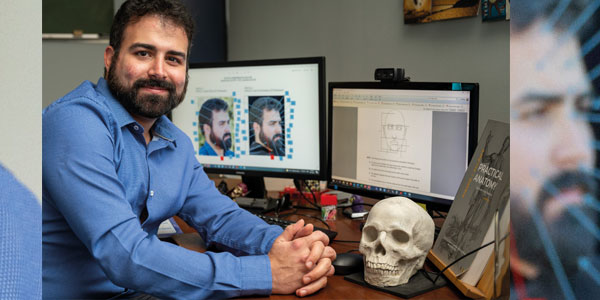Identifying faces to recognise humanity
- Leanne Rencken
The development of the Wits Face Database: An African database of high-resolution facial photographs.
Dr Nicholas Bacci has got a lot going on, which is the way he likes it. His Twitter profile describes him as a forensic anthropologist, anatomist, husband, beard grower and boring human being. Almost everything about that description is true.

A Lecturer in the School of Anatomical Sciences at Wits, bearded Bacci has two main research paths that demand most of his time. Simply put, these are his “facial identity work” and his investigations into lightning fatalities and bone trauma, both of which are equally fascinating. Then there is the constant stream of “what ifs” and ideas that he jots down in his little black book, because there is just so much that he would like to do, but so little time.
In a conversation that never strays far from his work, Bacci describes himself as obsessive, passionate, curious and determined and anyone who has encountered him will agree that this is the more accurate portrayal. Not a boring bone in sight.
When we met, he was putting together an application for a Thuthuka grant to support his ongoing facial identity work. This is an off-the-cuff reference to his most intensive project yet: The development of the Wits Face Database: an African database of high-resolution facial photographs and multimodal closed-circuit television recordings.
The title of the paper, published in 2021, refers to the collection of 6 220 facial photographs of 622 matching individuals in five different views, as well as corresponding CCTV footage of 334 individuals recorded under different realistic conditions
Mapping faces for identification
Why has he focused on creating this database? Until now, most databases have been developed in Europe, the US or China, and so many databases end up being biased towards white and Asian males. This results in several facial recognition algorithms training on databases that don’t serve specific populations at all, with oftentimes detrimental consequences.
However, it’s important to be clear: Bacci is concerned with facial identification and not facial recognition, and there is a significant difference between the two. “There is a very common misunderstanding where the two are confused: grouping the automated systems, and the psychological process of facial recognition with facial identification, which is meant to be a forensic application,” he explains.
Facing off against crime
A very manual application, human-based facial identification is an emerging field with its origins in facial mapping. Many people are surprised by when Bacci explains that he is not working on facial recognition or developing machine learning algorithms, but that he is rather creating a system that is more inclusive than any system currently available but which he also hopes will help law enforcement with suspect prosecution and missing person identification.
“It’s more of a reactive measure,” he explains. “If there’s surveillance footage of a potential crime, it can help with associating a suspect to a criminal scenario that was under surveillance, or if there are images or a body we cannot identify due to various reasons, it can possibly help with missing person identification.”
He adds: “This research is literally just scratching the surface. We have so much data that I think it’s very short-sighted if we don’t investigate using the data to address crime.”
If he is awarded the Thuthuka grant, Bacci plans to expand his database, increase the number of male subjects and add female faces to his photographic pool. In addition, he will be able to support the onboarding of a PhD candidate to help to process the information as well as build a mobile photographic unit, to allow for more efficiency and uniformity in the gathering of this data.
From lockdowns to load shedding, it’s been a difficult and protracted experience trying to put this database together – especially considering that it is a manual process. Each face in the database is scored against an accepted list of criteria and the comparisons are made through the scores generated for these criteria, rather than by putting two faces together side by side and looking for similarities and differences. Part of this database work is studying these faces and coming up with more relevant and detailed criteria for comparison and having those criteria reviewed, tested and accepted.
Lightning bolts to the bone
If that’s not enough, Bacci keeps a standard blue cooler box in his office – not for after-work drinks, but for the bones that he picks up from the butcher to further his other field of study. With help from Wits electrical engineers, he generates lightning under controlled conditions to see how skeletal remains react.
Through this multidisciplinary work, he and his colleagues have been able to determine that lightning strikes affect bone in a very particular way. They are now able to identify lightning-related deaths in skeletal remains, where previously this could only be done by way of markers left on the skin and the soft tissues of recent deaths.
At its core, the work Bacci is doing is making connections – whether it’s between faces, or between lightning and bone, or critically, between different disciplines. It is something at which he is good at and much of the success that he has achieved can be attributed to his collaborative approach both within and beyond the University.
He connects the dots that others sometimes cannot see and at heart wants to solve some key real-world problems through his innovative research.
- Leanne Rencken is a freelance writer.
- This article first appeared in?Curiosity, a research magazine produced by?Wits Communications?and the?Research Office. Read more in the 14th issue, themed: #Wits100 where we celebrate a century of research excellence that has shaped today and look forward to how our next-generation researchers will impact the next 100 years.

